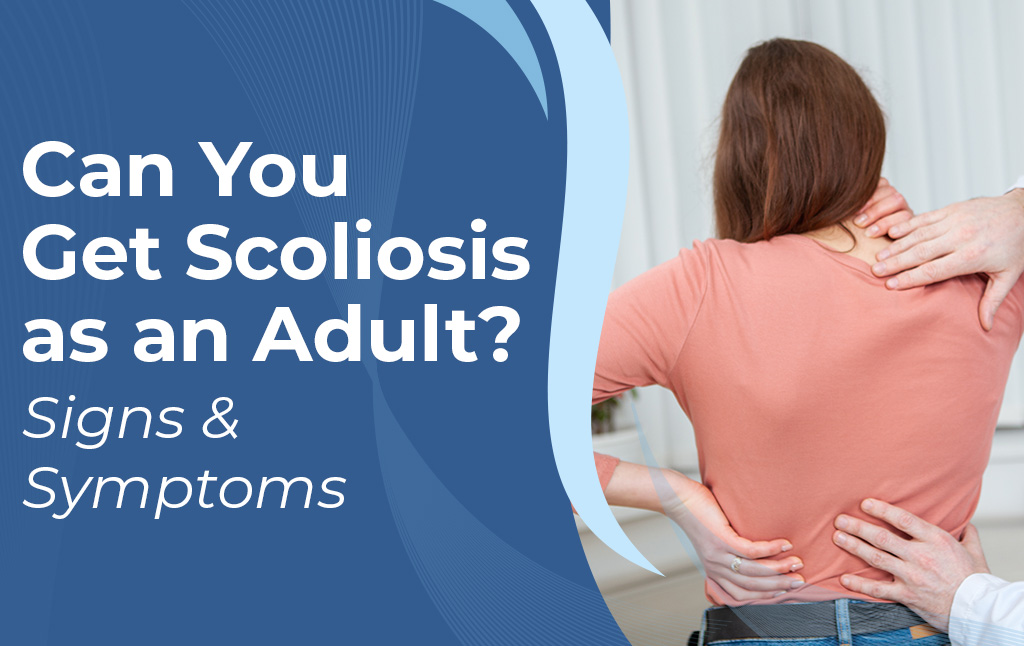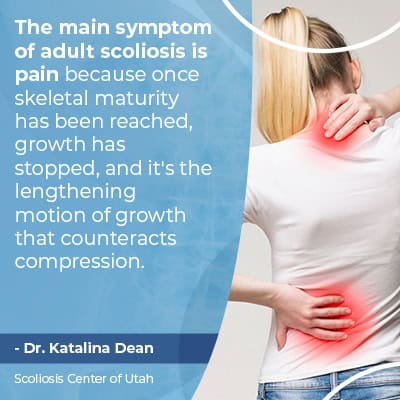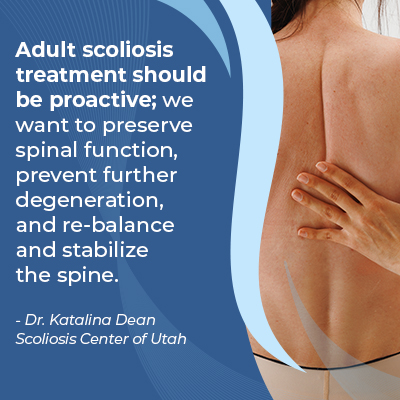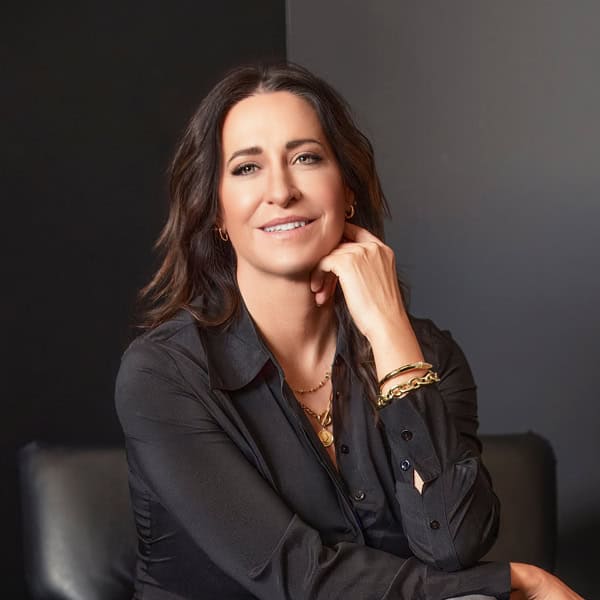Blogs
Can You Get Scoliosis as an Adult? Signs & Symptoms

When you get scoliosis as an adult, it can be a different experience than being diagnosed during childhood. Scoliosis becomes compressive in adulthood, making it painful. The lack of pain during growth can be a challenge to the early detection of childhood scoliosis, which if left untreated can become adult idiopathic scoliosis.
Although it’s most often diagnosed in children, you can also get scoliosis as an adult. The two main types to affect adults are idiopathic adolescent scoliosis and degenerative scoliosis, and the main symptom of adult scoliosis is pain.
Let’s start our exploration of adult scoliosis by discussing the two main categories of adult scoliosis.
Adult Scoliosis
Most consider scoliosis to be a childhood condition, but the actual rate of scoliosis increases among the aging population, and the condition can affect all ages.
Scoliosis causes the spine to curve unnaturally to the side and twist, and as a progressive condition, it’s virtually guaranteed to get worse over time.
As progression is triggered by growth, a key focus of childhood scoliosis is achieving a significant curvature reduction and working to sustain results during growth; while adult scoliosis tends to progress slower, it can still progress, and once age-related spinal degeneration starts occurring, an adult’s spine can become increasingly unstable.
In addition to ranging widely in severity from cases of mild scoliosis to moderate scoliosis and severe cases, there are also different types of scoliosis.
The main type of scoliosis overall is idiopathic scoliosis: no known cause. The vast majority of scoliosis cases are idiopathic, and the remaining cases have known causes: neuromuscular scoliosis, congenital scoliosis and degenerative scoliosis.
Neuromuscular scoliosis is caused by a larger neuromusuclar condition disrupting communication between the brain and spine, and babies are born with congenital scoliosis due to a malformed spine.
The best way to avoid developing complications related to scoliosis is through early diagnosis and treatment.
So let’s talk about the main categories of adult scoliosis: idiopathic and degenerative.
Adolescent Scoliosis in Adults
Adolescent scoliosis in adults (ASA) is the most common type of adult scoliosis, and adolescent idiopathic scoliosis diagnosed during adolescence, before or during puberty, and is the most prevalent type overall.
Adolescents are also the most at risk for rapid progression due to the unpredictable nature of pubescent growth spurts.
As mentioned earlier, scoliosis in children isn’t always easy to detect, particularly when mild, so if an adolescent’s subtle scoliosis signs are missed and the condition is neither diagnosed nor treated during the adolescent years, it can progress with time and growth into adulthood.
Idiopathic adolescent scoliosis can remain stable over time, or it can progress, and this is assessed through X-rays, but if scoliosis wasn’t diagnosed during adolescence and earlier X-ray image aren’t available, it can be a more challenging process to identity a pre-existing scoliosis in adults.
It can be difficult to imagine not noticing changes related to an unnatural spinal curve in adolescents, but as mentioned, during growth, scoliosis isn’t generally painful, and the main symptoms of scoliosis in children involve postural changes that can be mild and difficult to detect.
In many cases of childhood scoliosis, the earliest signs are uneven shoulders and hips, but these changes can be subtle and easily concealed. When/if scoliosis becomes painful, it’s easier to detect, but the reality is that by this time, a significant amount of progression has already occurred, and this makes it more complex to treat and less responsive to non-surgical treatment options.
After pre-existing untreated adolescent scoliosis, degenerative scoliosis is the next most common type to affect adults.
Degenerative Scoliosis
Degenerative scoliosis is also known as de novo scoliosis, meaning it has developed in adulthood with no prior history, unlike adolescent scoliosis in adults.
Degenerative scoliosis is caused by spinal degeneration that’s age-related so affects older adults, typically over the age of 45.
Degenerative scoliosis more commonly affects females than males, and this is due to changes related to menopause: bone density and hormones.
Spinal degeneration most often involves the joints and discs and causes instability in the spine, putting adults at risk of a fall, which is an increasing risk for older patients.
Because degenerative scoliosis involves a spine that’s degenerating and becoming more unstable over time, most cases of degenerative scoliosis are progressive.
Elderly Scoliosis
As mentioned earlier, scoliosis is more often diagnosed during childhood, but the actual rate of scoliosis increases in the elderly population (65+).
Approximately two-thirds of older adults will experience scoliosis caused by age-related spinal degeneration: mainly due to the spinal joints breaking down.
Elderly scoliosis generally involves a larger spinal section, most often a C-shaped curve in the lumbar spine (lower back).
As the spine becomes unstable and shifts out of alignment, it’s out of balance, and this can affect an older person’s balance as a whole.
The presence of additional spinal conditions such as osteoporosis, bone spurs, and degenerative changes to the spine’s intervertebral discs are contributing factors to the development of elderly scoliosis.
Symptoms of Adult Scoliosis
 The main symptom of adult scoliosis is pain because once skeletal maturity has been reached, growth has stopped, and it’s the lengthening motion of growth that counteracts compression.
The main symptom of adult scoliosis is pain because once skeletal maturity has been reached, growth has stopped, and it’s the lengthening motion of growth that counteracts compression.
Once scoliosis becomes a compressive condition, it tends to become painful, and this can involve muscle pain, back pain, and nerve pain.
Nerve compression causing pain in the extremities is a common type of adult scoliosis pain that leads to assessment and diagnosis. Compressed nerves can also cause a number of strange sensations such a as tingling, numbness, and/or weakness in the affected area.
When it comes to elderly scoliosis, this can involve chronic pain as there is too much movement within the spine due to instability.
Changes in posture are also common in adults, including a prominent lean to one side and a general stooped-forward position. Uneven shoulders and hips are also common.
Limited mobility can develop in cases of adult scoliosis, and this can be due to pain and/or postural changes causing disruptions to balance, coordination, and the development of an uneconomical gait.
A muscular imbalance can also develop as a symptom of scoliosis. The uneven forces of scoliosis don’t just disrupt the spine’s balance, but the spine’s surroundings and the body’s overall symmetry. An unnatural spinal curve can pull the spine’s surrounding muscles in different directions as they struggle to counteract the spine’s unnatural bend and twist.
So now that we know the different types of scoliosis that commonly affect adults, and their common symptoms and causes, let’s talk about treatment options.
Adult Scoliosis Treatment
 Adult scoliosis treatment should be proactive; we want to preserve spinal function, prevent further degeneration, and re-balance and stabilize the spine.
Adult scoliosis treatment should be proactive; we want to preserve spinal function, prevent further degeneration, and re-balance and stabilize the spine.
Here at the Scoliosis Center of Utah, we’re prepared to handle the unique challenges of addressing scoliosis in adults, and as many cases of adult scoliosis are progressive, being proactive is important.
Comprehensive assessment (physical examinations, digital X-rays, and digital posture analysis) is the first step to improving adult scoliosis; this allows us to customize a treatment plan based on a patient’s individual case and experienced symptoms.
A customized treatment plan has the goal of improving the spine’s alignment, which is the underlying cause of scoliosis symptoms like pain.
Our revolutionary treatment options for adult scoliosis include the ScoiBrace® system and advanced Chiropractic BioPhysics® (CBP).
The 3-dimensional corrective power of bracing combined with the science of CBP may stop progression and preserve existing spinal function for a better quality of life.
Conclusion
To summarize, the two main types of scoliosis to affect adults include pre-existing idiopathic adolescent scoliosis and degenerative scoliosis.
While some cases of adolescent scoliosis in adults remain stable over time, others progress becoming more unstable and causing compressive pain.
Most cases of degenerative scoliosis will be progressive because the spine is experiencing degenerative changes that make it particularly vulnerable to instability; the spinal joints are breaking down and the discs that sit between adjacent vertebrae are degenerating.
Symptoms of adult scoliosis can include pain ranging in severity, a muscular imbalance, postural changes, movement changes, balance changes, and nerve compression.
If scoliosis is left untreated and continues to progress, surgical procedures can become necessary, and spinal surgery is always invasive and risky, particularly for aging adults.
Here at the Center, every case of adult scoliosis is comprehensively assessed so a customized treatment plan can be crafted around key patients and condition variables for the best potential results.
While no treatment results can ever be guaranteed, the sooner scoliosis treatment is started, the better, so don’t hesitate to contact us for guidance and support.

Dr. Katalina Dean
Dr. Katalina Dean is the founder and clinical director of Scoliosis Center of Utah, in Midvale, UT. Her team specializes in posture correction, spinal rehabilitation, and non-invasive scoliosis care and bracing.
Call Today
Do You Qualify for Care?
Schedule an Appointment Below
